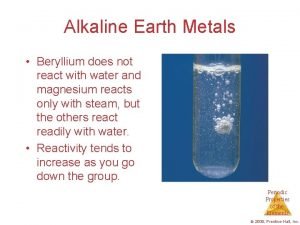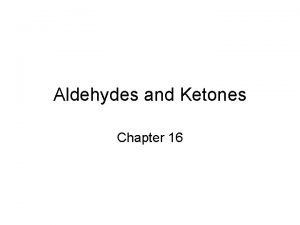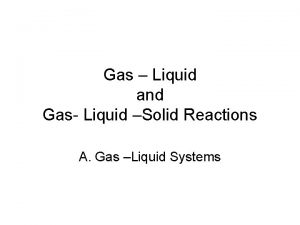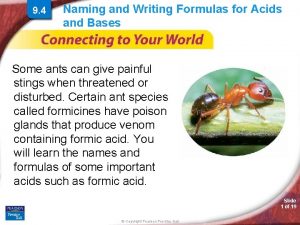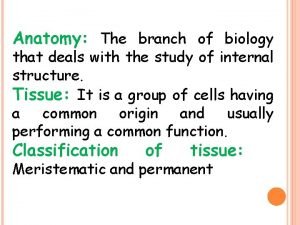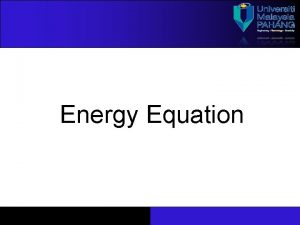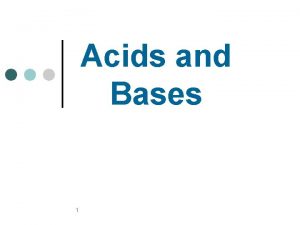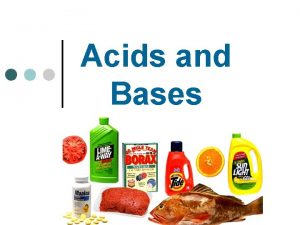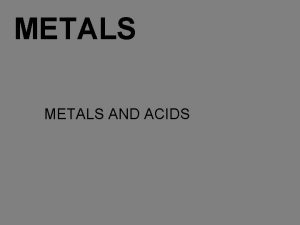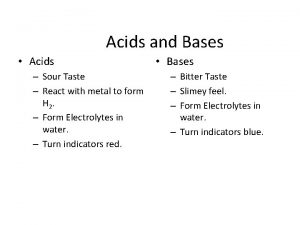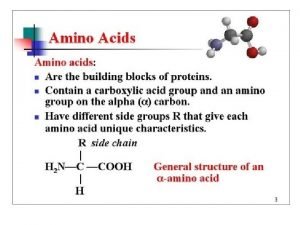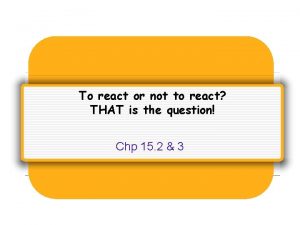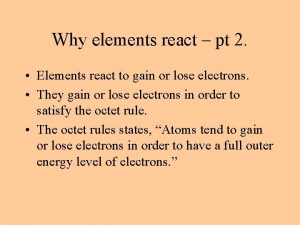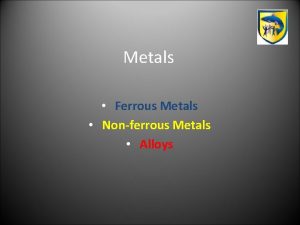Acids and Metals Acids react with certain metals





























- Slides: 29

Acids and Metals Acids react with certain metals to produce hydrogen gas and the metal salt. metal acid metal salt hydrogen gas Magnesium reacts rapidly with acid and forms a salt of magnesium and H 2 gas. © 2013 Pearson Education, Inc. Chapter 10, Section 5 1

Acids and Carbonates Acids react with carbonates or bicarbonates (hydrogen carbonate), to produce carbon dioxide gas, water, and an ionic compound (salt). The acid reacts with CO 32− to produce carbonic acid, H 2 CO 3, which breaks down rapidly to CO 2 and H 2 O. metal © 2013 Pearson Education, Inc. acid carbon dioxide Chapter 10, Section 5 metal salt water 2

Acid Rain Acid rain ▪ is a term given to precipitation, such as rain, snow, hail, or fog, that has a p. H of 5. 6 or less. ▪ is formed when sulfur impurities from coal and oil react with water and oxygen gas to form H 2 SO 4. ▪ degrades marble statues and limestone structures. ▪ interferes with photosynthesis, killing plants and trees. © 2013 Pearson Education, Inc. Chapter 10, Section 5 3

Acid Rain A marble statue in Washington Square Park has been eroded by acid rain. © 2013 Pearson Education, Inc. Acid rain has severely damaged forests in Eastern Europe. Chapter 10, Section 5 4

Learning Check Write the products and the balanced chemical equation for each of the following reactions of acids. © 2013 Pearson Education, Inc. Chapter 10, Section 5 5

Solution Write the products and the balanced chemical equation for each of the following reactions of acids. © 2013 Pearson Education, Inc. Chapter 10, Section 5 6

Neutralization Reactions Neutralization is the reaction of an acid, such as HCl and a base, such as Na. OH. acid base salt water ▪ The net ionic equation shows that H+ combines with OH− to form H 2 O, leaving the ions Na+ and Cl- in solution ▪ Crossing out spectator ions we get © 2013 Pearson Education, Inc. Chapter 10, Section 5 7

Guide to Balancing an Equation for Neutralization © 2013 Pearson Education, Inc. Chapter 10, Section 5 8

Balancing Neutralization Reactions Write the balanced equation for the neutralization of magnesium hydroxide and nitric acid. Step 1 Write the reactants and products. Step 2 Balance the H in the acid with the OH in the base. © 2013 Pearson Education, Inc. Chapter 10, Section 5 9

Balancing Neutralization Reactions Write the balanced equation for the neutralization of magnesium hydroxide and nitric acid. Step 3 Balance the H 2 O with the H and OH. Step 4 Write the salt from the remaining ions. © 2013 Pearson Education, Inc. Chapter 10, Section 5 10

Learning Check Write the balanced equation for the reaction of the base KOH with the strong acid, H 2 SO 4. © 2013 Pearson Education, Inc. Chapter 10, Section 5 11

Solution Write the balanced equation for the reaction of the base KOH with the strong acid, H 2 SO 4. Step 1 Write the reactants and products. Step 2 Balance the H in the acid with the OH in the base. © 2013 Pearson Education, Inc. Chapter 10, Section 5 12

Solution Write the balanced equation for the reaction of the base KOH with the strong acid, H 2 SO 4. Step 3 Balance the H 2 O with the H and OH. Step 4 Write the salt from the remaining ions. © 2013 Pearson Education, Inc. Chapter 10, Section 5 13

Learning Check Select the correct group of coefficients for the following neutralization equations. 1. A. 1, 3, 3, 1 B. 3, 1, 1, 1 C. 3, 1, 1, 3 A. 3, 2, 2, 2 B. 3, 2, 1, 6 C. 2, 3, 1, 6 2. © 2013 Pearson Education, Inc. Chapter 10, Section 5 14

Solution Select the correct group of coefficients for the following neutralization equations. 1. Answer is C. 3, 1, 1, 3. 2. Answer is B. 3, 2, 1, 6. © 2013 Pearson Education, Inc. Chapter 10, Section 5 15

Acid–Base Titration ▪ is a laboratory procedure often used to determine the molarity of an acid. ▪ uses a base, such as Na. OH, to neutralize a measured volume of an acid. © 2013 Pearson Education, Inc. Base (Na. OH) Acid solution Chapter 10, Section 5 16

Indicator An indicator ▪ is added to the acid in the flask. ▪ causes the solution to change color when the acid is neutralized. © 2013 Pearson Education, Inc. Chapter 10, Section 5 17

End Point of Titration At the end point, ▪ moles of OH− equal moles of H 3 O+ in the acid, and ▪ the indicator has a faint, permanent pink color. © 2013 Pearson Education, Inc. Chapter 10, Section 5 18

Concentration of the Acid From the measured volume of the Na. OH solution at the end point and its molarity, we calculate ▪ the number of moles of Na. OH used, ▪ the moles of acid in the flask, and ▪ the concentration of the acid. © 2013 Pearson Education, Inc. Chapter 10, Section 5 19

Guide to Calculations for an Acid–Base Titration © 2013 Pearson Education, Inc. Chapter 10, Section 5 20

Calculating Molarity from a Titration with a Base What is the molarity of an HCl solution if 18. 5 m. L of a 0. 225 M Na. OH are required to neutralize 10. 0 m. L HCl? Analyze the Problem. © 2013 Pearson Education, Inc. Chapter 10, Section 5 21

Calculating Molarity from a Titration with a Base What is the molarity of an HCl solution if 18. 5 m. L of a 0. 225 M Na. OH are required to neutralize 10. 0 m. L HCl? Step 1 Write the balanced equation for the neutralization. Step 2 Write a plan to calculate molarity or volume. liters molarity of Na. OH © 2013 Pearson Education, Inc. moles mole–mole Na. OH factor Chapter 10, Section 5 moles divide HCl by liters molarity 22

Calculating Molarity from a Titration with a Base What is the molarity of an HCl solution if 18. 5 m. L of a 0. 225 M Na. OH are required to neutralize 10. 0 m. L HCl? Step 3 State equalities and conversion factors. 1 L Na. OH and 0. 225 mole Na. OH 1 L Na. OH 1 mole of Na. OH = 1 mole of HCl 1 mole Na. OH and 1 mole HCl 1 mole Na. OH © 2013 Pearson Education, Inc. Chapter 10, Section 5 23

Calculating Molarity from a Titration with a Base What is the molarity of an HCl solution if 18. 5 m. L of a 0. 225 M Na. OH are required to neutralize 10. 0 m. L HCl? Step 4 Set up the problem to calculate the needed quantity. 0. 0185 L Na. OH x 0. 225 mole Na. OH x 1 mole HCl 1 L Na. OH 1 mole Na. OH = 0. 00416 mole HCl = 0. 416 M HCl 0. 0100 L HCl © 2013 Pearson Education, Inc. Chapter 10, Section 5 24

Learning Check Calculate the volume in liters of 2. 00 M H 2 SO 4 required to neutralize 50. 0 m. L (0. 0500 L) of 1. 00 M KOH. A. 0. 0125 L B. 0. 0500 L C. 0. 0200 L © 2013 Pearson Education, Inc. Chapter 10, Section 5 25

Solution Calculate the volume in liters of 2. 00 M H 2 SO 4 required to neutralize 50. 0 m. L (0. 0500 L) of 1. 00 M KOH. H 2 SO 4(aq) + 2 KOH(aq) K 2 SO 4(aq) + 2 H 2 O(l) Step 1 Write the balanced equation for the neutralization. H 2 SO 4(aq) + 2 KOH(aq) K 2 SO 4(aq) + 2 H 2 O(l) Step 2 Write a plan to calculate molarity or volume. liters of KOH © 2013 Pearson Education, Inc. molarity KOH moles KOH mole–mole factor Chapter 10, Section 5 moles H 2 SO 4 molarity H 2 SO 4 liters H 2 SO 4 26

Solution Calculate the volume in liters of 2. 00 M H 2 SO 4 required to neutralize 50. 0 m. L (0. 0500 L) of 1. 00 M KOH. Step 3 State equalities and conversion factors. 1 L KOH and 1. 00 mole KOH 1 L KOH 2 moles of KOH = 1 mole of H 2 SO 4 2 moles KOH and 1 mole H 2 SO 4 2 moles KOH © 2013 Pearson Education, Inc. Chapter 10, Section 5 27

Solution Calculate the volume in liters of 2. 00 M H 2 SO 4 required to neutralize 50. 0 m. L (0. 0500 L) of 1. 00 M KOH. Step 3 State equalities and conversion factors. 1 L of H 2 SO 4 = 2. 00 moles of H 2 SO 4 1 L H 2 SO 4 and 2. 00 moles H 2 SO 4 1 L H 2 SO 4 © 2013 Pearson Education, Inc. Chapter 10, Section 5 28

Solution Calculate the volume in liters of 2. 00 M H 2 SO 4 required to neutralize 50. 0 m. L (0. 0500 L) of 1. 00 M KOH. Step 4 Set up the problem to calculate the needed quantity. 0. 0500 L KOH x 1. 00 mole KOH x 1 mole H 2 SO 4 1 L KOH 2 moles KOH x 1 L H 2 SO 4 = 0. 0125 L H 2 SO 4 2. 00 moles H 2 SO 4 Answer is A. © 2013 Pearson Education, Inc. Chapter 10, Section 5 29
 Reactions of alkaline earth metals
Reactions of alkaline earth metals Mg and cold water
Mg and cold water Metals react with nonmetals to form ionic compounds by
Metals react with nonmetals to form ionic compounds by Nonmetals on the periodic table
Nonmetals on the periodic table Metal characteristics
Metal characteristics Grade 7 natural science term 3 notes
Grade 7 natural science term 3 notes Term 2 natural science grade 7
Term 2 natural science grade 7 Example of metals
Example of metals Examples of alloy metals
Examples of alloy metals A cart is pushed and undergoes a certain acceleration
A cart is pushed and undergoes a certain acceleration Significant
Significant Certain infectious and parasitic diseases
Certain infectious and parasitic diseases Wittig reaction mechanism
Wittig reaction mechanism Signals that tell your mind and body how to react.
Signals that tell your mind and body how to react. Multiphase reactor
Multiphase reactor Collision theory states that
Collision theory states that Naming and writing formulas for acids and bases
Naming and writing formulas for acids and bases Household items that are bases
Household items that are bases Naming and writing formulas for acids and bases
Naming and writing formulas for acids and bases Certain things hang on forever
Certain things hang on forever Theres a certain slant of light meaning
Theres a certain slant of light meaning Come sleep o sleep summary
Come sleep o sleep summary At a certain petrol pump customers arrive
At a certain petrol pump customers arrive An informed guess or assumption about a certain problem
An informed guess or assumption about a certain problem Certain factor
Certain factor Type of cell
Type of cell A certain light bulb
A certain light bulb There was once a man in russia long ago
There was once a man in russia long ago A moving point to point
A moving point to point Emech equation
Emech equation
